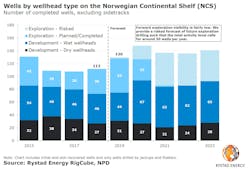Exploration, subsea boost for drillers offshore Norway
Offshore staff
OSLO, Norway – Wells drilled offshore Norway are approaching record levels last seen in 2013 and 2015, according to Rystad Energy.
“Our preliminary analysis shows that a total of 130 wells are likely to be drilled this year – a 16% increase compared to 2018,” said Eivind Drabløs, an analyst on Rystad’s offshore rig team.
“The increased activity this year relates primarily to an uptick in exploration drilling, a segment that will see around 55 wells completed.”
Rystad expects the high activity level to be maintained throughout the coming winter season and into 2020, with thereafter around 30 to 50 exploration wells drilled annually through 2023.
Subsea development wells are also set to rise from early 2020 onwards with the upsurge continuing for several years.
Johan Castberg, Snorre Expansion, and the still to be sanctioned Wisting project in the Barents Sea should lead to long-term contracts for harsh-environment semis. However, Rystad expects demand for dry tree development wells associated with wellhead platforms to flatten out.
Although offshore drilling share prices have fallen sharply over the past year, the analyst points out, rig rates and utilization are rising. Average day rates offshore Norway are presently around $300,000 for floaters, up 76% since they bottomed out during the oil and gas downturn.
“The offshore rig market is propelled by the increased sanctioning of greenfield projects, coupled with a substantial amount of brownfield work aimed at maintaining legacy production,” said Oddmund Føre, head of the offshore rig team.
“Some E&P companies are even increasing exploration efforts in a quest to replace declining reserves, resulting in a ‘trickle-down’ effect that is driving up rig counts and day rates.”
10/16/2019
